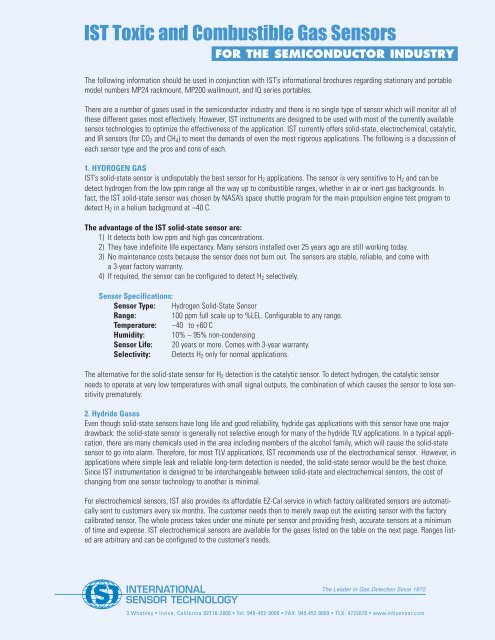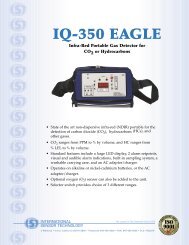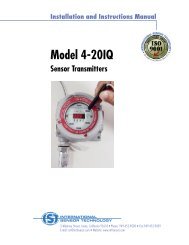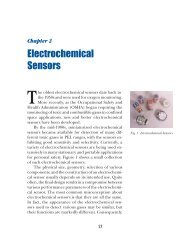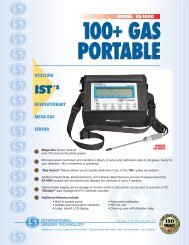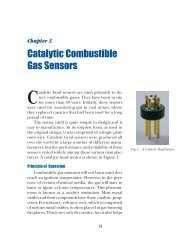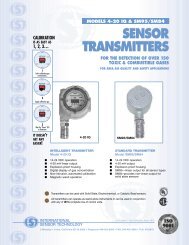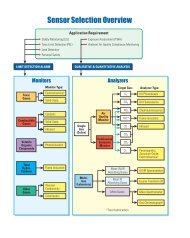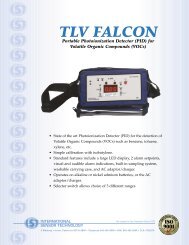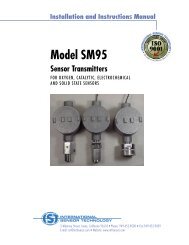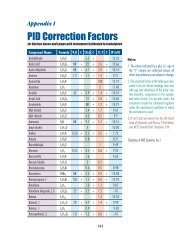Sensors for Semi-Conductor Industry (PDF) - International Sensor ...
Sensors for Semi-Conductor Industry (PDF) - International Sensor ...
Sensors for Semi-Conductor Industry (PDF) - International Sensor ...
You also want an ePaper? Increase the reach of your titles
YUMPU automatically turns print PDFs into web optimized ePapers that Google loves.
IST Toxic and Combustible Gas <strong><strong>Sensor</strong>s</strong><br />
FOR THE SEMICONDUCTOR INDUSTRY<br />
The following in<strong>for</strong>mation should be used in conjunction with IST’s in<strong>for</strong>mational brochures regarding stationary and portable<br />
model numbers MP24 rackmount, MP200 wallmount, and IQ series portables.<br />
There are a number of gases used in the semiconductor industry and there is no single type of sensor which will monitor all of<br />
these different gases most effectively. However, IST instruments are designed to be used with most of the currently available<br />
sensor technologies to optimize the effectiveness of the application. IST currently offers solid-state, electrochemical, catalytic,<br />
and IR sensors (<strong>for</strong> CO 2 and CH 4 ) to meet the demands of even the most rigorous applications. The following is a discussion of<br />
each sensor type and the pros and cons of each.<br />
1. HYDROGEN GAS<br />
IST’s solid-state sensor is undisputably the best sensor <strong>for</strong> H 2 applications. The sensor is very sensitive to H 2 and can be<br />
detect hydrogen from the low ppm range all the way up to combustible ranges, whether in air or inert gas backgrounds. In<br />
fact, the IST solid-state sensor was chosen by NASA’s space shuttle program <strong>for</strong> the main propulsion engine test program to<br />
detect H 2 in a helium background at –40 C.<br />
The advantage of the IST solid-state sensor are:<br />
1) It detects both low ppm and high gas concentrations.<br />
2) They have indefinite life expectancy. Many sensors installed over 25 years ago are still working today.<br />
3) No maintenance costs because the sensor does not burn out. The sensors are stable, reliable, and come with<br />
a 3-year factory warranty.<br />
4) If required, the sensor can be configured to detect H 2 selectively.<br />
<strong>Sensor</strong> Specifications:<br />
<strong>Sensor</strong> Type: Hydrogen Solid-State <strong>Sensor</strong><br />
Range: 100 ppm full scale up to %LEL. Configurable to any range.<br />
Temperature: –40 to +60 C<br />
Humidity: 10% – 95% non-condensing<br />
<strong>Sensor</strong> Life: 20 years or more. Comes with 3-year warranty.<br />
Selectivity: Detects H 2 only <strong>for</strong> normal applications.<br />
The alternative <strong>for</strong> the solid-state sensor <strong>for</strong> H 2 detection is the catalytic sensor. To detect hydrogen, the catalytic sensor<br />
needs to operate at very low temperatures with small signal outputs, the combination of which causes the sensor to lose sensitivity<br />
prematurely.<br />
2. Hydride Gases<br />
Even though solid-state sensors have long life and good reliability, hydride gas applications with this sensor have one major<br />
drawback: the solid-state sensor is generally not selective enough <strong>for</strong> many of the hydride TLV applications. In a typical application,<br />
there are many chemicals used in the area including members of the alcohol family, which will cause the solid-state<br />
sensor to go into alarm. There<strong>for</strong>e, <strong>for</strong> most TLV applications, IST recommends use of the electrochemical sensor. However, in<br />
applications where simple leak and reliable long-term detection is needed, the solid-state sensor would be the best choice.<br />
Since IST instrumentation is designed to be interchangeable between solid-state and electrochemical sensors, the cost of<br />
changing from one sensor technology to another is minimal.<br />
For electrochemical sensors, IST also provides its af<strong>for</strong>dable EZ-Cal service in which factory calibrated sensors are automatically<br />
sent to customers every six months. The customer needs then to merely swap out the existing sensor with the factory<br />
calibrated sensor. The whole process takes under one minute per sensor and providing fresh, accurate sensors at a minimum<br />
of time and expense. IST electrochemical sensors are available <strong>for</strong> the gases listed on the table on the next page. Ranges listed<br />
are arbitrary and can be configured to the customer’s needs.<br />
INTERNATIONAL<br />
SENSOR TECHNOLOGY<br />
The Leader In Gas Detection Since 1972<br />
3 Whatney • Irvine, Cali<strong>for</strong>nia 92718-2806 • Tel. 949-452-9000 • FAX: 949.452.9009 • TLX: 4722070 • www.intlsensor.com
Table 1<br />
Gas Symbol EL Range SS Range TLV<br />
Ammonia NH 3 100 ppm 50 ppm 25.00 ppm<br />
Arsine AsH 3 1 1 0.05<br />
Bromine Br 2 5 20 0.10<br />
Chlorine Cl 2 5 5 0.50<br />
Chlorine Dioxide ClO 2 10<br />
10 0.10<br />
Diborane B 2 H 6 1 10<br />
0.10<br />
Fluorine F 2 5 20<br />
0.10<br />
Germane GeH 4 5 10<br />
0.20<br />
Hydrogen Bromide HBr 50<br />
50<br />
3.00<br />
Hydrogen Chloride HCl 50<br />
50<br />
5.00<br />
Hydrogen Fluoride HF 10<br />
50<br />
3.00<br />
Nitrogen Oxide NO 2 20 20 3.00<br />
Phosgene COCl 2 1 50<br />
0.10<br />
Phosphine PH 3 1 3<br />
0.30<br />
Silane SiH 4 50 10 5.00<br />
Oxygen O 2 ppm to deficiency n/a n/a<br />
Ozone O 3 1 5<br />
0.10<br />
Nitrogen Trifluoride NF 3 50<br />
50<br />
10.00<br />
Tetraethyl Orthosilicate TEOS 50<br />
100 10.00<br />
HYDRIDE SENSOR SPECIFICATIONS:<br />
<strong>Sensor</strong> Type: Electrochemical <strong>Sensor</strong> Hydride Solid-State <strong>Sensor</strong><br />
Range: Listed in Table 1. Others available; consult factory. Listed in Table 1. Others available; consult factory.<br />
Temperature: 0 o to 40 o C –40 o to +60 o C<br />
Humidity: 20 – 90% relative humidity, non-condensing 10% - 95% non-condensing<br />
<strong>Sensor</strong> Life: 1 – 2 years; comes with 1-year warranty 10 years or more; come with 3-year warranty<br />
Selectivity: Very good Non-selective<br />
SENSOR TRANSMITTER TECHNICAL SPECIFICATIONS:<br />
Model Numbers: 4-20IQ, SM95<br />
Power:<br />
14-24 VDC<br />
Current Drain:<br />
400 mA<br />
Output Current: 4-20 mA non-isolated (isolated optional) or 100 to 500 mA<br />
Temperature:<br />
-40 o to +60 o C<br />
Humidity:<br />
15% - 96% non-condensing<br />
Controls: 4-20IQ: Span, zero, heater, and alarm setpoints. Magnetic wand to activate switches <strong>for</strong><br />
non-intrusive automated calibration.<br />
SM95: Conventional pot adjustment <strong>for</strong> zero, span, and heater.<br />
Display: 4-20IQ: LED display<br />
SM95: None<br />
Fault:<br />
Output current goes to 0 mA<br />
Dimensions: 4-20IQ: 4.54"H x 7.82"L x 5.05"W (116mm x 200mm x 129mm) Weight: 3.89 lbs (1.77 kg)<br />
SM95: 2.85"H x 8.87"L x 3.8"W (73mm x 226mm x 97mm) Weight: 2.9 lbs. (1.32 kg)<br />
Case:<br />
UL, CSA Certified Class I, Division I, Groups B,C, and D<br />
CELENEC Approvals Pending<br />
Approvals <strong>for</strong> use with solid state sensors only


